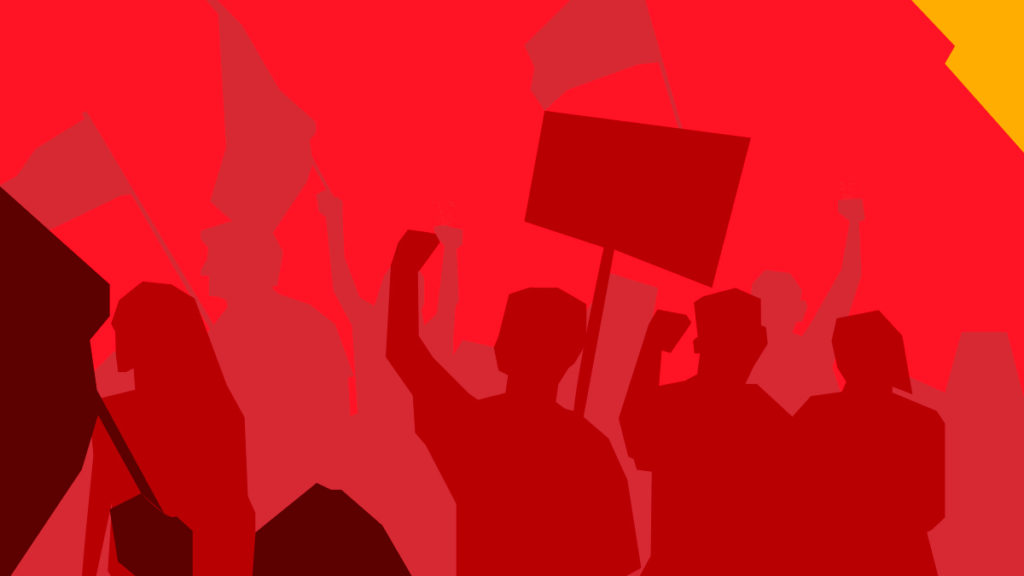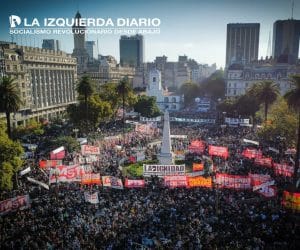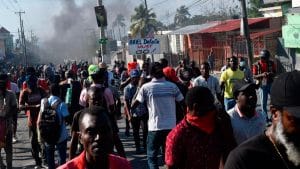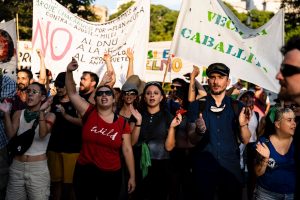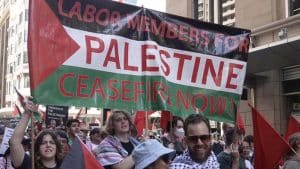Since the outbreak of the capitalist crisis in 2008, there have been two major international cycles of class struggle. In the first cycle in the “West” (to use the term as developed by Antonio Gramsci in his Prison Notebooks), we saw essentially peaceful revolts like the Indignados Movement in Spain, also known as the 15-M Movement (for May 15, 2011). That was followed by the wave of demonstrations in Istanbul’s Gezi Park, in Turkey, beginning in late May 2013, and massive demonstrations in several Brazilian cities in June 2013. Major crises such as in Greece in 2010 led to sharper class-struggle processes. The more “Eastern” scenarios of the “Arab Spring” that confronted dictatorships took on a much more violent form, as in Egypt in 2011, where the Tahrir Square movement ended up marking the beginning of a revolutionary process that was put down with blood and fire.
We are now going through a second cycle. Its opening bell was sounded by the eruption of the Yellow Vests in France in late 2018. Unlike the Indignados, they began in the context of a higher and more violent level of class struggle, and were met with repression that had not been seen for a long time within the imperialist democracies. This added important contingents from the lowest and most precarious layers of the working class, especially from the suburbs,[1] to the sectors that had been the protagonists of the previous cycle of class struggle. They targeted Macron’s government, demanding its ouster, and even had elements of self-organization such as the “Assemblies of the Assemblies” (which, however, never fully developed).
We also see higher levels of confrontation in the second Catalan uprising that is ongoing, and in the protests that are taking place in Hong Kong. Meanwhile, uprisings in Algeria and Sudan have reactivated the “Arab Spring.” In war-torn Iraq, there have been massive protests against unemployment and the high cost of living—repression has left a trail of dead bodies. Crowds in Lebanon are mobilizing against the government. In Latin America, the revolutionary days that Chile has experienced, and Ecuador beforehand on a smaller scale, are part of a cycle of class struggle that includes Puerto Rico, Honduras, and Haiti, with more acute confrontations with the armed forces and more repression in the streets.
The backdrop to these processes is not a great catastrophe such as a war or an economic crash, as in the first half of the 20th century, but a creeping crisis of capitalism that has gone through different moments since 2008. Especially now, in the second cycle, this particularity means that two different sectors have become the protagonists.
The first sector is what we might call, for want of a better name, the “relative losers” of globalization—those who had made some progress, even if not enough to climb out of poverty, and then watched the crisis thwart their expectations of further advances. This group runs the gamut: from young university students (“well educated” by capitalist standards); to the underemployed and those in precarious jobs, who played a decisive role in the first post-2008 cycle in Europe; to what is euphemistically referred to in Latin America as the “nueva clase C,”[2] comprised largely of salaried workers who have risen out of poverty (thanks to the commodities boom) only to find themselves colliding with, for example, the decay of public services (as in Brazil).
The other large sector could be called globalization’s “absolute losers.” These are the impoverished and precariously employed, if not unemployed—working-class people, as well as many young people, who were essentially excluded from the “social pact” of neoliberalism. In many cases, they have been relegated to the fringes of the big cities. They are often stigmatized by the bourgeoisie and in the big media outlets. It is this second group that is leaving its mark, particularly in this second cycle of class struggle. We saw them burst into the streets in the center of Paris and the toll roads across France wearing Yellow Vests. We see them now in the Chilean process, including many of the more than half a million so-called “Ni/Ni” (neither/nor) youth, neither in school nor holding jobs, who face special repression and are criminalized in their neighborhoods.
In this second cycle, both sectors form the glue that holds the protests together. The eruption of the “absolute losers” gives a more violent and explosive character to this second cycle of class struggle. But the two cycles share a fundamental characteristic: they have more the the dynamics of a revolt than of a revolution.
Revolts and the “Extended State”
Revolts are comprised of spontaneous actions that unleash the energy of the masses. They may feature significant levels of violence. Unlike revolutions, however, they do not aim to replace the existing order, but rather to pressure it into giving concessions. There is no wall between the two, however. A revolt contains the possibility of overcoming its nature as mere acts of resistance or of extreme pressure. Moments in the process of a revolt can be the same as those that open a revolutionary situation. It all depends on how they develop, and especially on whether the working class and mass movement can advance in their consciousness and organization.
In this new cycle, we have seen both the potential and the limits of this dynamic of revolt. They have shown how to stop the capitalist attacks in the streets, as we saw in the revolutionary days against Macron in France, in Ecuador against Moreno, and now in Chile against Piñera. They have even ousted governments, such as those of Boutleflika in Algeria, Al Bashir in Sudan, and Rosselló in Puerto Rico. However, the reforms they lead to—such as those proposed today in Chile—are superficial and remain within the framework of a capitalist structure that continually increases inequality and is wracked by crisis. Even if a government falls, this remains within the framework of regimes that the masses reject.
These limits correspond to a distinctive characteristic of the revolt, which is that the mass movement intervenes in a disorganized manner. At present, this is expressed primarily by the “citizen” character of revolts. Social networks and new technologies—which in recent processes have been very useful from a number of perspectives, such as denouncing police and army repression in Chile, for example—also contribute to this sense of atomization. Calls for action can go viral, but without generating spaces for deliberation and organization. This leads to a sort of “verticality” that becomes an obstacle to self-organization, as in the case of the protest app Tsunami Democràtic in the Catalan uprising.
Within this framework, the working class that controls the “strategic positions” that keep society running (transport, big industries, and services) abstains, with few exceptions, from using its decisive power. Instead, it intervenes as part of the “citizenry,” diluted within “the people” in general. The decades of neoliberal offensive have not been in vain. During this time the working class has expanded as never before in history, but it has also become much more heterogeneous and and fragmented. At the same time, the socio-political structure of the state today is designed to consolidate this fragmentation. An “extended state” goes far beyond “waiting passively” for consensus and is instead dedicated to “organizing” it through the state control of mass organizations and the development of bureaucracies within them (beginning with the unions). This guarantees the fracturing of the working class.
We saw this in France, where not only the yellow bureaucracies like that of the CFDT (French Democratic Confederation of Labor, one of France’s five major trade union confederations), but also the supposedly “combative” leadership of the CGT (General Confederation of Labor), were careful to keep the unionized sectors—which occupy “strategic positions”—away from the Yellow Vests movement. We saw it in Ecuador, where the CONAIE (Confederation of Indigenous Nationalities of Ecuador) pulled the indigenous movement off the streets of Quito at the height of the confrontations with the government. We currently see it in Chile, where the union, student, and social bureaucracies of the Social Unity Roundtable are struggling to enter into a dialogue with the government as the streets resound with cries of “Out with Piñera!”
The absence of workers’ hegemony means that the movement will express itself in this “citizen” form, even though many of its protagonists are part of the working class. This fact is based on the heterogeneity of the movements, composed, as we wrote earlier, of globalization’s “absolute losers” and “relative losers.” This is also used by the bourgeoisie, the state, and the media to divide the movement into “good,” “legitimate” demonstrators and “violent,” “uncivilized” ones. With the former, there is the possibility of trying out some minimal concessions to get them off the streets. To shut down the latter group, they must be criminalized.
The strategic question is how to keep the explosions of hatred and class struggle that are expressed in revolts from exhausting themselves. They can end because of cosmetic reforms that change nothing substantive, or by being channeled into schemes of this or that bourgeois political variant (be it of the Right or the Left), or as a result of counterattacks or Bonapartist solutions. The question is how instead to unleash their potential and somehow manage to open the road from revolt to revolution. The key element is the development of working-class hegemony that manages to unite the different sectors in struggle.
The Chilean Process
One of the most important processes of the present cycle of class struggle is taking place in Chile. It is a society marked by inequality, in which 26.5% of the country’s net wealth is concentrated in the hands of the richest 1%, whereas 50% of the poorest households have only 2.1% of the wealth. This is where the “relative losers” are those who have barely escaped from poverty during the last decade (who, according to official statistics, went from 29.1% in 2006 to 8.6% in 2017), but live in a country in which everything is privatized and the costs of one person’s illness can bankrupt their entire family. In Chile, 21% of young people between ages 18 and 29 are delinquent debtors. There are also the “absolute losers”—a half-million “Ni/Ni” youth, and the 1.5 million who are trapped in poverty despite the economic boom.
In the beginning, it was high school students who came out against the transit fare hike, awakening the sympathy of millions and thus initiating the revolutionary days. The repressive response of Piñera’s government, with the military occupying the streets, drove increasingly massive popular anger in Santiago and its impoverished suburbs, and then nationally, with barricades, protests with people banging pots and pans, burnt buses, a great deal of looting of big retailers, and the burning of police stations and public buildings. And then sectors of the organized labor movement began to join, such as the dockworkers and a sector of the miners. The central bureaucracy of the CUT trade union confederation, lagging behind events, tried to call a “strike with empty streets” that later became a routine strike.
A new moment arrived with the mass mobilization of Friday, October 25, which in Santiago alone greatly surpassed 1 million people, although in a peaceful and festive climate, different from the mobilizations of the first moment. In response, Piñera cynically greeted the demonstration by redoubling, along with a massive media campaign, the attempts to separate the “legitimate” demonstrators (“the families”) from the “violent ones,” that is, the poor in the suburbs and the youth who faced repression in the streets. The CUT bureaucracy, practicing the opposite of workers’ hegemony—which could link up the different sectors the regime wants to divide, and could have taken form in the strengthening of pickets and self-defense against the military that acted as a virtual occupation army—sealed its routine participation in the strike last Wednesday by promoting a march in which it was careful to omit the slogan “Out with Piñera!”
“Citizen” Mobilization and Class Power
In Chile, Piñera has presented a so-called “social agenda” that grants some crumbs to protect the regime inherited from the Pinochet dictatorship. In addition to this, he is carrying out a series of institutional maneuvers (cabinet reshuffling, parliamentary negotiation with the opposition, etc.) in order to keep himself in power. Faced with the persistence of the mobilizations, although with less intensity, sectors of the regime have begun to propose some type of constituent assembly as a means of institutional recomposition. The Communist Party and the Frente Amplio (Broad Front), which have already transformed “Out with Piñera!” into a mere “constitutional accusation” (a type of impeachment), have also introduced the idea of a “constituent process” within the framework of the regime. Thus, there is currently a dispute, both over the demand “Out with Piñera!” and over the proposal for a rigged constituent assembly to save the regime.
In opposition to these maneuvers, we revolutionary socialists instead propose a free and sovereign constituent assembly that is truly capable of expressing the will of the people and has full powers. This can only be imposed by the masses through their actions, on the ruins of the current regime, making “Out with Piñera!” a reality. Radical-democratic slogans such as for a “constituent assembly” can play a very important role, not because there is some democratic stage through which the mass movement must necessarily pass, but because, as Trotsky pointed out, “The proletariat can skip the stage of democracy, but we cannot skip the stages of the development of the proletariat.” [3]
In this sense, it is important to make clear that while a constituent assembly such as the one we have just described is capable of expressing the will of the people, it is a very different matter for it to have the power, in and of itself, to impose the demands of the mass movement. The latter necessarily implies overcoming the resistance of the capitalists. As Ferdinand Lassalle pointed out in his classic 1862 speech “On the Essence of Constitutions”:
The King’s [today it is the Executive branch of government] political instrument of power, the army, is organized, constantly mobilized, disciplined and ever ready to act; the power of the nation, on the contrary, even when it is far greater, is unorganized.[4]
The Constituent Assembly, in Trotsky’s words, is “the most democratic form of parliamentary representation,” [5] but the capitalist state is based on an army, on repressive forces that have a bourgeois class character. No one should expect them to accept peacefully any decision that actually goes against the capitalists. One need go no further than Pinochet’s 1973 coup to prove the point. The bourgeois state must be opposed with a true alternative power of the working class.
In this sense, the slogan of the constituent assembly can play an important pedagogical role. In the very struggle to impose these measures against the resistance of the bourgeois order with its armed forces (and paramilitary organizations), ever broader sectors of working people can take their experience with representative democracy to the very end, understand the need to break definitively with the conception of atomized “citizens,” and instead organize in the workplaces, factories, transportation sectors, schools, universities, and so on to develop their own democratic organs of power and their own organizations of self-defense. This is precisely how workers’ councils and soviets emerge.
In fact, the cordones industriales in the 1970s (organs of workers’ power during the Allende government) developed similarly in the face of reaction. In October 1972, with more than 500 factories occupied, they formed the most important line of resistance to the bourgeoisie’s first attempt at a coup. However, they did not manage to transform themselves into a real (armed) power alternative to the bourgeois state and its military forces. This is largely due to the policies of the Communist Party and the Socialist Party, which continually sought to hold them back, and the absence of a revolutionary party that would have fought for their development in this direction.
The objective of the constituent assembly slogan can be met if it is possible—around the assembly, or in the case of it taking place, in defense of its resolutions—to defeat the (bourgeois) state with its armed forces and develop the organs of working-class power (soviets and militias) capable of replacing it.[6] As Trotsky pointed out with respect to Russia, “the question was posed of whether it was possible to transform the Constituent Assembly and the Soviets into organs of one and the same class, and not at all of ‘combining’ a bourgeois Constituent Assembly with the proletarian Soviets.”[7]
Hegemony and Party
The current cycle of class struggle poses the same task: not uncritically assimilating the “citizen” forms that the revolt adopts today, but rather fighting for the working class to intervene in its own name and represent the different sectors in struggle. Hence the importance of developing coordinating committees and bodies of self-organization, which could be the seeds of future workers’ councils (soviets) as an alternative power of the working class and the oppressed. This is also the case with respect to the struggle against the union bureaucracy, which—as we saw in France with the Yellow Vests or as we see today in Chile—seeks to restrict the organized labor movement to union struggles, on the one hand, and “citizen” politics on the other, thus separating it from the rest of the working class and limiting its potential to fulfill a hegemonic role.
It would be wrong to think that workers’ hegemony and soviet-type organizations will develop spontaneously as the class struggle sharpens. There needs to be a revolutionary political organization of sufficient weight that is capable of organizing the vanguard with this “soviet” perspective, and with a program that confronts not only this or that government but the entire bourgeois regime. As Trotsky wrote in The History of the Russian Revolution, “Lenin’s workers”—that is, workers educated in a revolutionary transitional program through the political agitation of the Bolsheviks—were fundamental to defeating tsarism in the Russian Revolution of February 1917. [7] Equivalent workers must be forged by a revolutionary party today.
In Chile, one notes the absence of a revolutionary party with these characteristics and with a national presence. Our comrades of the Revolutionary Workers Party (PTR) are fighting to build such a party. In Argentina, the recent electoral campaign of the Workers Left Front—Unity (FIT-U), reaching the broadest masses with a transitional program to confront the entire regime, has contributed to putting the revolutionary left in a better position as the class struggle unfolds further—be it the process taking place today on the other side of the Andes, in Chile, or similar processes elsewhere. That’s what it’s all about.
Notes
1. In much of the world, but rarely in the United States, it is in the suburbs ringing the great cities that the poorest, most marginalized in society often live.—trans.
2. The bourgeois press often refers to this as the “new digital middle class.”—trans.
3. Leon Trotsky, “Latin American Problems: A Transcript,” November 4, 1938.
4. Ferdinand Lassalle, “On the Essence of Constitutions,” speech delivered in Berlin, April 16, 1862.
5. Leon Trotsky, “The Chinese Question After the Sixth Congress,” October 4, 1928.
6. There are proposals that seem to overlook this vital question of the class character of the state, such as that of Jorge Altamira, who maintains that we must fight for “a sovereign Constituent Assembly that assumes the political leadership of the state,” but who knows which class’s state he means. (Altamira was a longtime leader of Argentina’s Partido Obrero [Workers’ Party] and its five-time presidential candidate, until a recent split.—trans.)
7. Leon Trotsky, “A Letter on the Italian Revolution,” May 14, 1930.
8. Leon Trotsky, The History of the Russian Revolution, chapter 8, in which he refers to “conscious and tempered workers educated for the most part by the part of Lenin.”–trans.
First published in Spanish on November 3 in Ideas de Izquierda.
Translation: Scott Cooper


